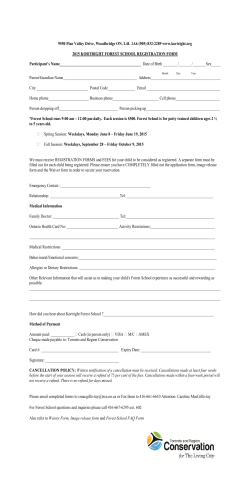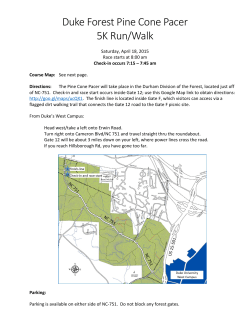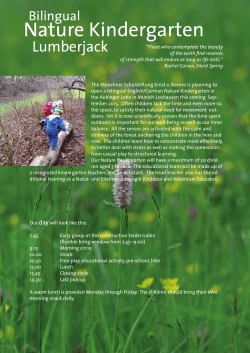
Comments - Maine Forest Products Council
Maine Forest Products Council The voice of Maine March 16, 2015 RE: Docket No. FWS–R5–ES–2011–0024 Endangered and Threatened Wildlife and Plants; Listing the Northern Long-Eared Bat with a Rule under ESA Section 4(d) Dear Sir or Madam: The U.S. Fish and Wildlife Service (Service) has proposed to list the northern long-eared bat (NLEB) under the Endangered Species Act (ESA). The determination of the listing as either endangered or threatened is due this April. In the event that the listing status is determined to be threatened, the Service has proposed a section 4d rule under the ESA that would, in areas affected by white-nose syndrome (WNS), exempt incidental take attributable to forest management practices, maintenance and limited expansion of transportation and utility rights-of-way, removal of trees and brush to maintain prairie habitat, and limited tree removal projects from the take prohibition, if those activities are conducted in accordance with the following habitat conservation measures, as applicable: (i) (ii) (iii) Occur more than 0.25 mile (0.4 km) from a known, occupied hibernacula; Avoid cutting or destroying known, occupied maternity roost trees during the pup season (June 1–July 31); and Avoid clearcuts within 0.25 (0.4 km) mile of known, occupied maternity roost trees during the pup season (June 1–July 31). The Service in their proposed 4(d) rule also state that “We do not consider conversion of a mixed forest into an intensively managed monoculture pine plantation as forest management covered under this proposed rule, as typically these types of monoculture pine plantations provide very poor-quality bat habitat.” In the event that the Service finds that the NLEB warrants an endangered status listing, the proposed 4(d) rule is not applicable and would be withdrawn. The Service may also find that the NLEB does not warrant any listing under the ESA at this time. The following comments are provided by the Maine Forest Products Council. Since 1961, the Maine Forest Products Council has been the voice of Maine’s forest economy. The MFPC represents the diverse needs of Maine’s forest products community. We speak for logging contractors, sawmills, paper mills, biomass energy, facilities, pellet manufacturers, furniture manufacturers, and on behalf of more than nine million acres of commercial forestland in Maine. Private forest lands in Maine have a long history and ongoing interest in incorporating wildlife and biodiversity into the management of working forests. Over 9 million acres (60% of Maine forestland) is certified under forest certification systems that address species of concern and biodiversity. Maine forest owners also are leaders in scientific research through their involvement in the University of Maine’s Cooperative Forestry Research Unit. 535 Civic Center Drive, Augusta, Maine 04330 207-622-9288 [email protected] www.maineforest.org Comments Summary The potential listing of the NLEB and implementation of a 4(d) rule has large potential ramifications to the member organizations of the MFPC. Like the Service, we value science and the role it has in guiding the management of our natural resources. We agree with the Service that forest management has not been a factor in the decline of the NLEB and is not involved in WNS, the agent causing the decline. We support the Service and States’ recognition of the contributions that forest management provides to the conservation of NLEB and other bats. Should the Service determine that a listing is warranted, a threatened listing under the ESA would better allow our member organizations to continue their forest management businesses and practices that benefit bats through the adoption of a 4(d) rule. The proposed 4(d) rule could be improved by changes to how monoculture tree plantations are addressed and how habitat conservation measures are prescribed around hibernacula and maternity tree roosts. Details on these topics are discussed below. Comment Details 1. Support the Service and States’ recognition of the contributions that forest management provides to the conservation of NLEB and other bats. The Service has appropriately recognized the contribution that forest management provides to the bat community through multiple actions such as: · Maintenance of forest land cover in landscapes that provide habitat; · Maintenance of healthy and diverse forests through addressing forest health issues that arise from time to time, such as pests, fire, invasive species, disease, etc.; · Consideration of and retention of bat habitat during forest management practices such as snag and wildlife tree retention, patch retention, riparian habitat retention, water quality protection measures, etc.; · Conducting forest management under the guidance and monitoring of sustainable forestry certification programs; · Creation of early successional and young forest habitat that provides abundant primary vegetation production and its associated insect habitat, a source of prey for the bat community. State government support for forest management and its role in bat conservation is further detailed in the letter by Boggess et al. (Boggess, E., N. Wiley, P. Church, and G. Geissler. 2014. Letter to Dan Ashe, Director, USFWS, re: Docket # FWS-R5-ES2011-0024. 18p. See https://www.fws.gov/midwest/endangered/mammals/nlba/ pdf/ MAFWA_SEAFWA_NLEBletter5Nov2014.pdf). Additional comments on this topic can be found in the National Council for Air and Stream Improvement’s (NCASI) March 2015 comment letter for this listing and 4(d) rule proposal. 2. Support for a threatened listing should the Service determine a listing is warranted. As the Service considers whether or not the NLEB warrants to be listed under the ESA, we encourage the Service to consider the points made by NCASI in their December 20, 2013 comments on the 12-month Finding on a Petition to List the NLEB as an Endangered Species. Their comments included: 535 Civic Center Drive, Augusta, Maine 04330 207-622-9288 [email protected] www.maineforest.org · · · · · The Service should not assume that population trends for the NLEB are the same throughout the species’ range. Availability of forest habitat is not limiting to populations of the NLEB. Forest management activities are not adversely affecting or limiting populations of the NLEB. A landscape containing a diversity of forest canopy structures will likely be required to support the entire bat community and forest management is an important tool for managers seeking to provide that diversity. Providing a landscape- and population-level management approach may be more effective in conserving the NLEB than a site-level, individual animal approach. 3. The Service should reconsider their statement on the suitability of pine plantations for bat habitat. The Service states in the proposed 4(d) rule that “conversion of a mixed forest into an intensively managed monoculture pine plantation as forest management covered under this proposed rule, as typically these types of monoculture pine plantations provide very poor-quality bat habitat” (80 FR 2374 – 2375). There are multiple lines of evidence that monoculture pine or other tree species plantations may not adversely impact bat occupancy of areas where these plantations are located. Detailed study citations on this topic can be found in the National Council for Air and Stream Improvement’s (NCASI) March 2015 comment letter for this listing and 4(d) rule proposal. Summary points include: · · · · Although one tree species may be planted for a particular forest stand, through the harvest design and natural succession of the site, there is typically other vegetation within and adjacent to the particular planted site. This includes for example snag retention, wetland and riparian area vegetation retention, and natural “volunteer” tree species that invade the planted site. This provides diversity at both the stand and landscape scale. Net change in planted forests is minimal within the range of the NLEB. Many studies in managed pine plantation forests have observed NLEB’s. Distance to water and the vertical and horizontal structure of the forest stand may be more important factors that influence the suitability of a particular forest stand than its tree species composition. 4. The Service should reconsider the 0.25 mile radius no harvest buffer measure surrounding hibernacula and the no clearcutting 0.25 mile measure for maternity roost sites (during the pup season, June 1 to July 31). The proposed 4(d) rule indicates that, in areas affected by WNS, forest management practices within 0.25 mile (0.4 km) from a known occupied hibernacula will not be accepted from the take prohibition. The Service’s reason for adopting a 0.25-mile buffer is that it “should be sufficient to protect most known, occupied hibernacula and hibernating colonies” (80 FR 2374). The proposed 4(d) rule explains further that “This buffer will provide basic protection for the hibernacula and hibernating bats in winter from direct impacts, such as filling, excavation, blasting, noise, and smoke exposure. This buffer will also protect some roosting and foraging habitat around the hibernacula.” (80 FR 2374) It would be helpful if the Service could provide scientific evidence for these 0.25 mile buffer conservation measures. The direct impacts you cite, “…filling, excavation, blasting, noise, and smoke exposure” are not normal forestry activities. Maintaining the integrity of these hibernacula and maternity roost sites may be better accomplished with site-specific measures rather than a one-size rule. Site-specific measures could incorporate local conditions such as riparian areas, topography, suitable bat foraging and roosting habitat, etc. Roost trees are ephemeral and bats are known to switch roost sites during the season, often frequently, and between seasons 535 Civic Center Drive, Augusta, Maine 04330 207-622-9288 [email protected] www.maineforest.org among years. At the population level, NLEB’s and other species have been maintained to date, in the absence of WNS, in landscapes with managed forests and other mixes of land uses. This fact also supports the rationale that roost surveys are not required prior to forest management activities. Surveys would not be practical, as survey methods are limited to a brief time period, are effort-intensive and costly, and are likely not a wise use of limited conservation funds from states, federal agencies, or private entities. Further discussion of this topic can be found in the National Council for Air and Stream Improvement’s (NCASI) March 2015 comment letter for this listing and 4(d) rule proposal. We appreciate this opportunity to provide comments to the Service on this listing and 4(d) rule proposal. Please contact me if there are any needs for clarification or additional information. Sincerely, Patrick Strauch Executive Director 535 Civic Center Drive, Augusta, Maine 04330 207-622-9288 [email protected] www.maineforest.org
© Copyright 2025









